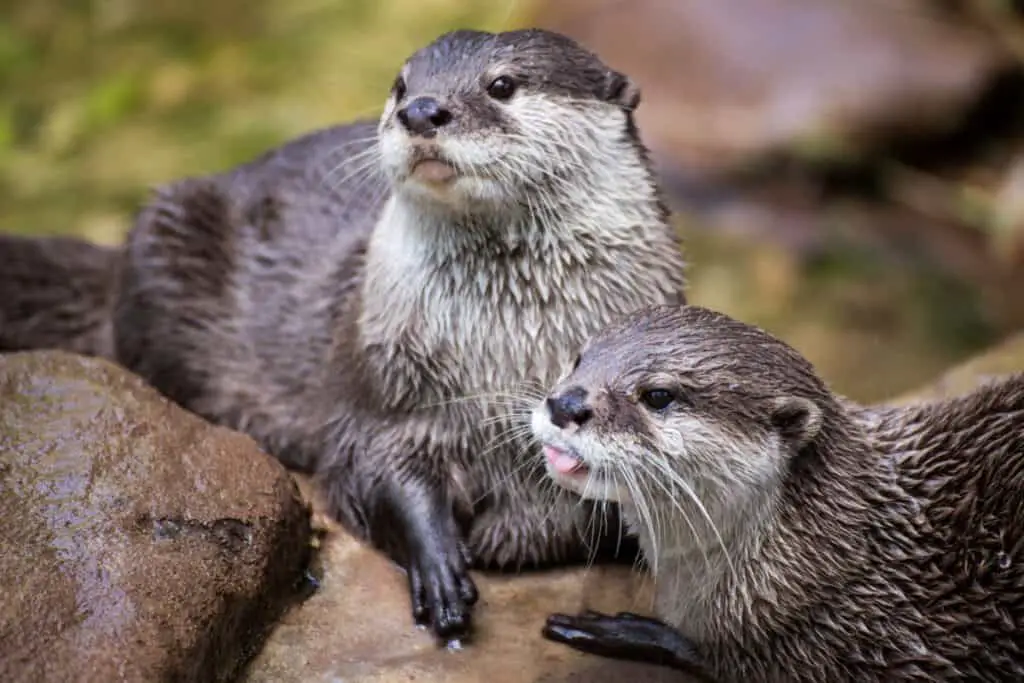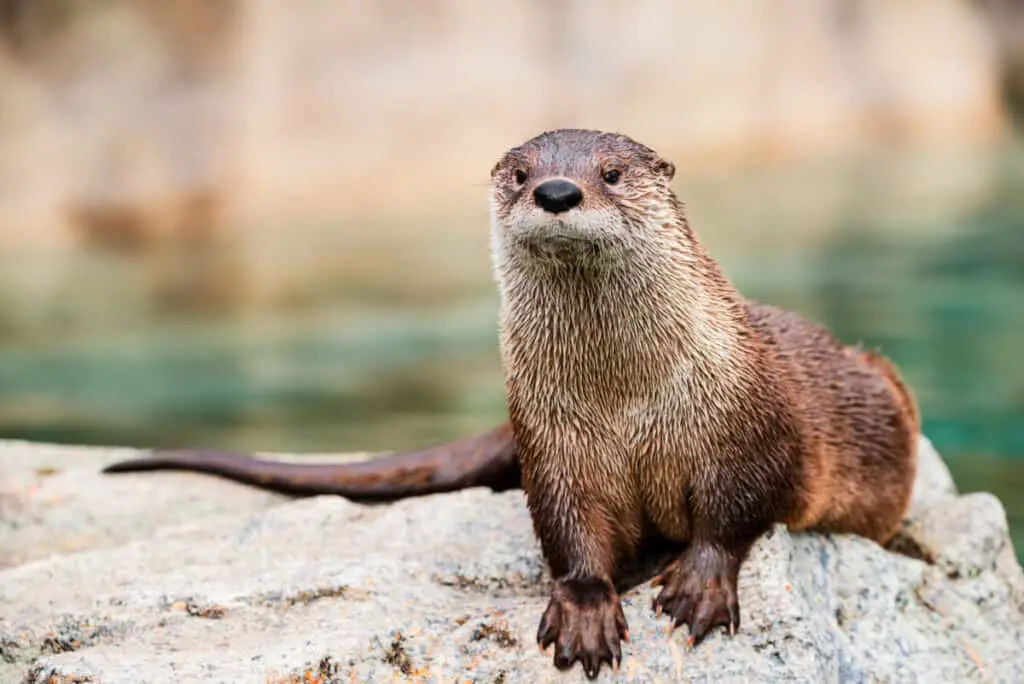The river otter, scientifically known as Lontra canadensis, is a semiaquatic mammal found throughout North America. These creatures belong to the family Mustelidae and are closely related to other weasel-like animals such as minks, ferrets, and badgers.
River otters have long been admired for their playful behavior and sleek appearance. They are carnivorous mammals that typically weigh between 10-30 pounds and measure up to 4 feet in length from nose to tail. Their fur is thick and waterproof, which helps them regulate body temperature while swimming in cold water. They possess webbed feet with sharp claws that allow them to navigate through rivers and streams with ease.
Although they primarily feed on fish, crayfish, and amphibians, they also consume small mammals or birds when prey is scarce. River otters play an important role in maintaining the ecological balance of aquatic ecosystems by controlling populations of invasive species such as carp or bullfrogs. However, habitat loss due to human activities has caused declines in river otter populations across the continent.

Taxonomy And Physical Characteristics
The river otter belongs to the family Mustelidae, which includes other carnivorous mammals such as weasels, ferrets, and badgers. Within this family, they are part of the subfamily Lutrinae along with other species of otters. River otters are found throughout North America in freshwater habitats such as rivers, lakes, and wetlands.
River otters have a sleek and streamlined body that is covered in dense fur. Their fur color varies depending on location but typically ranges from dark brown to black on their back and sides with lighter tan or grayish coloring on their belly.
This fur provides excellent insulation for them when swimming in cold water, helping them maintain a constant body temperature. Additionally, their thick underfur traps air bubbles close to their skin making them buoyant while swimming underwater.
The unique characteristics of a river otter’s fur play an important role in its survival within challenging aquatic environments.
Habitat And Distribution
As the old adage goes, ‘home is where the heart is.’ This sentiment rings true for river otters as they are highly dependent on their habitats.
The geographical range of river otters spans across North America, from Alaska to Florida and even down to Mexico. However, this mammal tends to prefer freshwater environments such as rivers, streams, lakes, and marshes.
In these preferred habitats, river otters can thrive due to the availability of food sources like fish and shellfish. They also require dense vegetation along the water’s edge for shelter and protection from predators.
Additionally, clean water is crucial for maintaining healthy populations of river otters as pollutants can harm not only them but also other organisms in their ecosystem.
Overall, understanding the habitat preferences and geographic range of river otters allows us to better protect these important members of our natural world.
Giant River Otters’ Predators Unmasked: A Fight for Survival
Adaptations For Aquatic Life
Evolutionary history has played a significant role in shaping the adaptations of river otters for aquatic life.
The ancestors of modern-day otters were semi-aquatic creatures that lived near rivers and lakes, but over time they have evolved to become highly specialized swimmers who can hold their breath underwater for up to eight minutes.
They have streamlined bodies with dense fur that helps them stay warm in cold water while also providing buoyancy.
Their webbed feet are designed for efficient swimming, and they use their powerful tails as rudders.
Behavioral patterns also contribute to the success of river otters in an aquatic environment.
Otters are social animals and often live in groups consisting of family members or unrelated individuals.
These groups work together when hunting for food, using coordinated techniques such as driving fish towards each other or herding them into shallow areas where they can be easily caught.
River otters are opportunistic feeders, consuming a wide variety of prey including fish, crustaceans, insects, and small mammals.
They are known for their playful behavior both on land and in water, which may help them develop important skills needed for survival such as agility, coordination, and problem-solving.
Overall, through evolutionary history and behavioral adaptation, river otters have developed remarkable characteristics that enable them to thrive in aquatic environments.
Feeding Habits And Role In Ecosystems
Aquatic life presents numerous challenges that require specialized adaptations for survival. One of the most impressive examples is the river otter, a highly skilled swimmer and hunter that thrives in freshwater environments across North America.
River otters have evolved several traits to make them effective aquatic predators, such as webbed feet, streamlined bodies, dense fur coats, and powerful tails for steering and propulsion. These features allow them to move through water with remarkable speed and agility while hunting prey like fish, crayfish, frogs, and small mammals.
Despite their seemingly effortless movements in the water, river otters are essential players in aquatic ecosystems due to their impact on prey populations. Their diet varies depending on location and season but typically consists of 50-80% fish. They prefer species like bass, catfish, sunfish, and trout which they catch using complex techniques involving dives up to 60 seconds long.
Otters also feed opportunistically on other available prey including crustaceans and amphibians. As top-level predators in many habitats, they help regulate prey populations by keeping them in check so that they do not overwhelm or damage the ecosystem. However, this delicate balance can become disrupted if human activities such as overfishing or pollution reduce food sources or degrade habitat quality for these charismatic animals.
Threats And Conservation Efforts
Conservation challenges for river otters are numerous. Human impact on the environment has led to habitat loss and degradation, which can have significant impacts on otter populations.
River pollution caused by industrial waste, agricultural runoff, and human development is also a major threat to their survival. Additionally, overfishing of prey species, particularly fish, affects the availability of food for otters.
Climate change may also affect water quality and availability in rivers where they live. These conservation challenges require immediate action from governments, NGOs, and individuals to protect these animals and their habitats through policies that address issues such as pollution control measures, sustainable fishing practices, reforestation efforts near aquatic ecosystems, and protection of wetlands to ensure sufficient freshwater sources for otters’ survival.
To effectively conserve the species requires collaboration between different stakeholders with an understanding of the importance of conserving biodiversity. It’s vital that people recognize how much we depend on healthy ecosystems for our own well-being—ecosystems that include charismatic species like river otters whose presence indicates clean waterways and functioning ecosystems overall.
Long-term monitoring programs should be established to assess population trends so researchers can quickly identify potential threats or changes in ecological conditions affecting them before it becomes too late for effective intervention strategies. Ultimately, successful conservation efforts will rely on the engagement of local communities living in proximity to vulnerable areas who understand both the benefits and value of protecting these animals and their habitats.

Fascinating Facts About River Otters
After discussing the threats and conservation efforts surrounding river otters, it is important to appreciate their fascinating behavior and communication patterns.
River otters are highly social animals that live in groups called raft or romp. These rafts consist of several adult females with their young offspring and a few males.
Otters communicate through vocalizations such as whistles, growls, screams, and chirps. They also use body language like tail slapping on water, posturing, grooming each other’s fur, and playing.
Observations suggest that otter behavior varies depending on their habitat. For instance, river otters living near urban areas tend to be more nocturnal than those residing in remote locations who are active during the day. Additionally, they have different foraging strategies where some prey on fish while others prefer crustaceans or mollusks.
It is interesting to note that even though they exhibit diverse behaviors based on geography and resource availability, these animals always remain playful regardless of their circumstances.
Studying animal behavior provides insight into how they adapt to changing environments over time. River otters’ ability to thrive despite facing numerous challenges shows us just how resilient nature can be when given a chance to recover from human-induced damage. By understanding their unique behavioral traits such as communication techniques and foraging habits we can better protect this charismatic species for future generations to enjoy.
Conclusion
The river otter is a fascinating animal that has adapted to thrive in aquatic environments. It belongs to the family Mustelidae, which includes weasels and badgers.
River otters have sleek, streamlined bodies with webbed feet and sharp claws for swimming and catching prey underwater.
These animals are found throughout North America in freshwater ecosystems such as rivers, streams, lakes, and marshes. They play an important role in these ecosystems by controlling populations of fish, crustaceans, and other small animals.
Despite being excellent swimmers and hunters, river otters face threats from habitat loss due to human activities such as pollution and development. Conservation efforts include reintroduction programs in areas where they once lived but were extirpated.
As the saying goes, ‘the proof of the pudding is in the eating.’ The success of conservation efforts will ultimately determine whether future generations will be able to witness the playful antics and ecological importance of this remarkable species.
